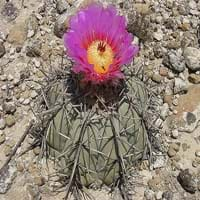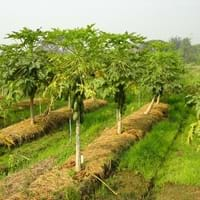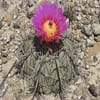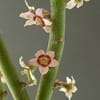Life Span
Perennial
Annual and Perennial
Type
Cactus or Succulent
Fruit
Origin
North America, Southwestern United States, Mexico
Mexico, Central America
Types
Colville's Barrel Cactus, Long-spined Barrel Cactus, Barrel Cactus
Male Papaya Tree, Female Papaya Tree, hermaphrodite Tree
Number of Varieties
Not Available
Habitat
limestone outcrops, Rocky areas, Semi desert
tropical environments, Tropical regions
USDA Hardiness Zone
12-15
10-15
AHS Heat Zone
12-10
12-10
Sunset Zone
12, 13, 21, 22, 23, 24
H1, H2, 21, 23, 24
Habit
Oval or Rounded
Upright/Erect
Flower Color
Yellow, Magenta
Ivory
Flower Color Modifier
Not Available
Bicolor
Fruit Color
Pink, Red
Green, Orange, Light Yellow
Leaf Color in Spring
Not Available
Dark Green
Leaf Color in Summer
Not Available
Dark Green
Leaf Color in Fall
Not Available
Dark Green
Leaf Color in Winter
Not Available
Light Green
Leaf Shape
Not Available
Irregular
Plant Season
Spring, Summer, Fall, Winter
Spring, Summer, Fall, Winter
Sunlight
Full Sun, Partial Sun
Full Sun, Partial Sun, Partial shade
Growth Rate
Slow
Very Fast
Type of Soil
Loam, Sand
Loam, Sand, Well drained
The pH of Soil
Acidic, Neutral, Alkaline
Acidic, Neutral
Soil Drainage
Well drained
Well drained
Bloom Time
Spring, Late Spring, Early Summer
Indeterminate
Tolerances
Drought
Drought
Where to Plant?
Container, Ground, Pot
Ground
How to Plant?
Seedlings
Seedlings
Plant Maintenance
Medium
Medium
Watering Requirements
Needs good drainage, Needs very little water, Water carefully
Average Water Needs, Do Not over Water, Do not water frequently, Requires watering in the growing season
In Summer
Lots of watering
Lots of watering
In Spring
Moderate
Moderate
In Winter
Average Water
Average Water
Soil pH
Acidic, Neutral, Alkaline
Acidic, Neutral
Soil Type
Loam, Sand
Loam, Sand
Soil Drainage Capacity
Well drained
Well drained
Sun Exposure
Full Sun, Partial Sun
Full Sun, Partial Sun, Partial shade
Pruning
No pruning needed
Remove damaged leaves, Remove dead branches, Remove dead leaves, Remove shoots, Remove short branches, Remove short twigs, Requires little pruning
Fertilizers
All-Purpose Liquid Fertilizer
14-14-14 Fertilizer
Pests and Diseases
Red blotch
Red blotch
Plant Tolerance
Drought
Drought
Flower Petal Number
Single
Single
Foliage Texture
Bold
Bold
Foliage Sheen
Not Available
Glossy
Attracts
Not Available
Ants, Bees, Hummingbirds
Allergy
Not Available
Asthma, breathing problems, Itchiness, Itchy eyes, Red eyes, Runny nose, sneezing, Sore eyes, Swelling, Watery eyes, wheezing
Aesthetic Uses
Showy Purposes
Not Used For Aesthetic Purpose
Beauty Benefits
Not Available
Good for skin, Good for skin and hair, Improve hair condition, Making cosmetics, Not Available
Edible Uses
Insignificant
Yes
Environmental Uses
Air purification
Air purification
Medicinal Uses
Not Available
Asthma, Bone strength, Cancer, Diabetes, Digestion problems, Heart problems, Inflammation, Skin Disorders
Part of Plant Used
Flowers
Fruits, Seeds
Other Uses
Used as Ornamental plant
Cosmetics, Making Shampoo, Used As Food, Used for its medicinal properties
Used As Indoor Plant
No
No
Used As Outdoor Plant
Yes
Yes
Garden Design
Container, Houseplant, Rock Garden, Wall
Container, Edible, Feature Plant, Fruit / Fruit Tree, Tropical
Botanical Name
ECHINOCACTUS horizonthalonius
CARICA papaya
Common Name
Devilshead, Turk's head cactus, Blue barrel cactus, Eagle's claw, Horse maimer, Horse crippler, Visnaga meloncillo
Papaya
In Hindi
Blue barrel cactus
पपीता
In German
Blau Faßkaktus
Papaya
In French
Bleu barrel cactus
Papaye
In Spanish
biznaga Azul
Papaya
In Greek
Μπλε βαρέλι κάκτος
Παπάγια
In Portuguese
cacto de tambor azul
Mamão
In Polish
Niebieski baryłkę kaktus
Papaja
In Latin
Blue Cactus
Papaya
Phylum
Magnoliophyta
Magnoliophyta
Class
Magnoliopsida
Magnoliopsida
Order
Caryophyllales
Brassicales
Family
Cactaceae
Caricaceae
Genus
Echinocactus
Carica
Clade
Angiosperms, Core eudicots, Eudicots
Angiosperms, Eudicots, Rosids
Tribe
Cacteae
Not Available
Subfamily
Cactaceae
Not Available
Number of Species
Not Available
Season and Care of Blue Barrel and Papaya
Season and care of Blue Barrel and Papaya is important to know. While considering everything about Blue Barrel and Papaya Care, growing season is an essential factor. Blue Barrel season is Spring, Summer, Fall and Winter and Papaya season is Spring, Summer, Fall and Winter. The type of soil for Blue Barrel is Loam, Sand and for Papaya is Loam, Sand, Well drained while the PH of soil for Blue Barrel is Acidic, Neutral, Alkaline and for Papaya is Acidic, Neutral.
Blue Barrel and Papaya Physical Information
Blue Barrel and Papaya physical information is very important for comparison. Blue Barrel height is 40.00 cm and width 13.00 cm whereas Papaya height is 457.20 cm and width 7.62 cm. The color specification of Blue Barrel and Papaya are as follows:
Blue Barrel flower color: Yellow and Magenta
Blue Barrel leaf color: Not Available
Papaya flower color: Ivory
- Papaya leaf color: Dark Green
Care of Blue Barrel and Papaya
Care of Blue Barrel and Papaya include pruning, fertilizers, watering etc. Blue Barrel pruning is done No pruning needed and Papaya pruning is done Remove damaged leaves, Remove dead branches, Remove dead leaves, Remove shoots, Remove short branches, Remove short twigs and Requires little pruning. In summer Blue Barrel needs Lots of watering and in winter, it needs Average Water. Whereas, in summer Papaya needs Lots of watering and in winter, it needs Average Water.





